Pink Anemonefish
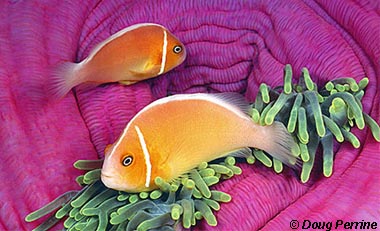
Amphiprion perideraion
These pink-orange, almond-shaped fish get their name from the color of anemone they usually inhabit. The small fish have a signature white line down their backs from nose to tail, and a white stripe separating head and body. They acclimated themselves to the stinging tentacles a specific anemone which becomes their home, usually with a small group consisting of a large female, a smaller breeding male, and sometimes a few non-breeding males. When the female dies, the largest male becomes a female and the males move up the hierarchy.
Order – Perciformes
Family – Pomacentridae
Genus – Amphiprion
Species – perideraion
Common Names
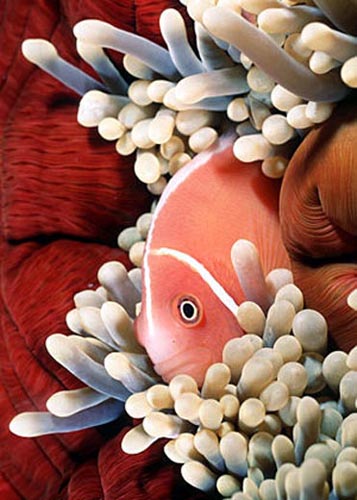
Their common name comes from the coloration of the species and where it makes its home. They have a pinkish orange coloration and live within different anemone species: Heteractis magnifica, Heteractis crispa, Mactodactyls doreenis, andStichodactyla gigantea. Other common names that are used to identify the species include false skunk striped clown, false skunkstriped anemonefish, pink anemonefish, pink skunk clown, salmon clownfish, whitebanded anemonefish (English); halsbånd-klovnfisk (Danish); iga ni gavoro (Gela); hanabira-kumanomi (Japanese); bombin, geger putih, gombing, inggu (Malay); amfiprion zloty (Polish); and vitpannad clownfisk (Swedish).
Importance to Humans
The pink anemonefish has commercial value as a popular aquarium fish. Aquarium suppliers often sell this hardy fish to aquarists in the retail market.
Conservation
The pink anemonefish is not listed on the World Conservation Union (IUCN) Redlist as an endangered species, nor is there any immediate plans to place the species on the list. The IUCN is a global union of states, governmental agencies, and non-governmental organizations in a partnership that assesses the conservation status of species.
> Check the status of the pink anemonefish at the IUCN website.
Geographical Distribution

The pink anemonefish is found in the Indian and Pacific Oceans. They occur around Christmas Island in the eastern Indian Ocean near the Philippines. Their range also includes the Philippine Islands, north to Japan, and throughout Micronesia south to Australia and east to the Samoan Islands.
Habitat
The pink anemonefish lives in tropical environments. They inhabit brackish and marine water areas associated with algal reefs as well as in lagoons. The pink anemonefish is a non-migratory fish, residing in the area where it is born. They primarily inhabit the magnificent sea anemone, Heteractis magniica, in reef systems for protection. The pink anemonefish is either innately protected or must go through a behavioral process called acclimation in order to live in with the anemone. Acclimation is where a species has to adjust to a new environment. Pink anemeonefish have to adjust to the stinging of anemones tentacles in order to live in the anemones.
Biology
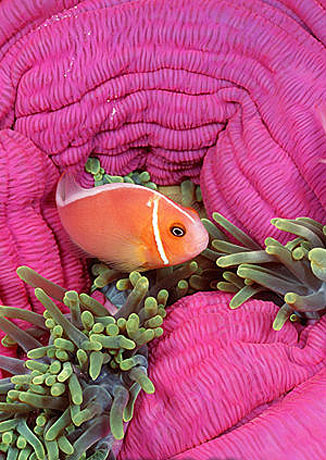
Distinctive Features
This genus Amphiprion is comprised of 26 described species, including the pink anemonefish. Characteristics of this oblong-shaped anemonefish include 50-59 vertical scale rows with horizontal scale rows from the dorsal fin to the lateral line numbering 3 to 4.
Coloration
The pink anemonefish has a pinkish-orange color with transparent fins. The male has narrow orange bands on the edge of the dorsal fin and the upper and lower margins of the tail fin while the female is lacking these bands. There is one white stripe following the dorsal contour from snout to caudal peduncle on the pink anemonefish. Also, these fish have one white vertical stripe between the head and trunk located right behind the eyes creating the appearance of a separate head and body with transparent fins. The two white stripes distinguish the pink anemonefish from other anemonefish because this is the only species with two stripes.
Dentition
Pink anemonefish have somewhat incisiform dentition – the close set teeth each resemble a typical incisor tooth.
Size, Age & Growth
The pink anemonefish grows to a maximum length of 3.93 inches (10 cm). The standard length for males is 1.85 inches (4.6 cm) and for females it is 2.20 inches (5.5 cm) during the age range of 1.75 to 1.83 years. They occur in social groups that contain only one sexually functional male and female and zero to three sexually nonfunctional sub-adults and juveniles.
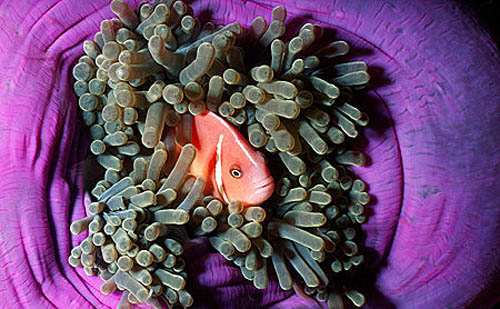
Food Habits
Algae is the primary food source for the pink anemonefish in the form of two types of phytoplankton: blue-green algae and diatoms. Benthic algae and zooplankton are also included in their diet.
Reproduction
The maturity age range for both male and female pink anemonefish is 1.75 to 1.83 years. When they reach maturity, reproduction takes place primarily between the months of April and August, but can occur in February. This species live in social groups that have a strict dominance hierarchy. The larger fish is always the female and the second largest is the male. They are the only two individuals that reproduce within the group. Pink anemonefish’s mode of reproduction is protandry in which only the testicular tissue matures. Under certain conditions- the death of the female- testicular tissue degenerates and the gonads change to ovaries, thereby allowing the fish to avoid self fertilization. The breeding pair will spawn several times per year via external fertilization with the annual fecundity estimated at 2,000 to 4,000 eggs.
Predators
Groupers of the family Serranidae are known predators of pink anemonefish in the waters around Marshall Islands.
Taxonomy
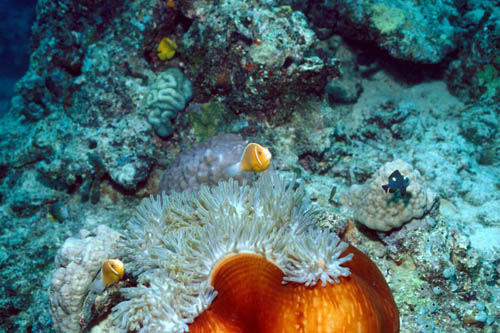
The pink anemonefish was first described by Bleeker (1855) as Amphiprion perideraion. The genus name Amphiprion is derived from the the Greek word “amphi” which means on both sides, around and the Greek word “prion” which means saw. In 1855 Bleeker used Prochilus perideraion to name the anemonefish in scientific literature. Other synonyms that have been used include Prochilus rosenbergi Bleeker 1859, Amphiprion rosenbergi Bleeker 1859, Amphiprion perideraeus Günther 1881, and Amphiprion amamiensis Mori 1966.Prepared by: Stephanie Boyer